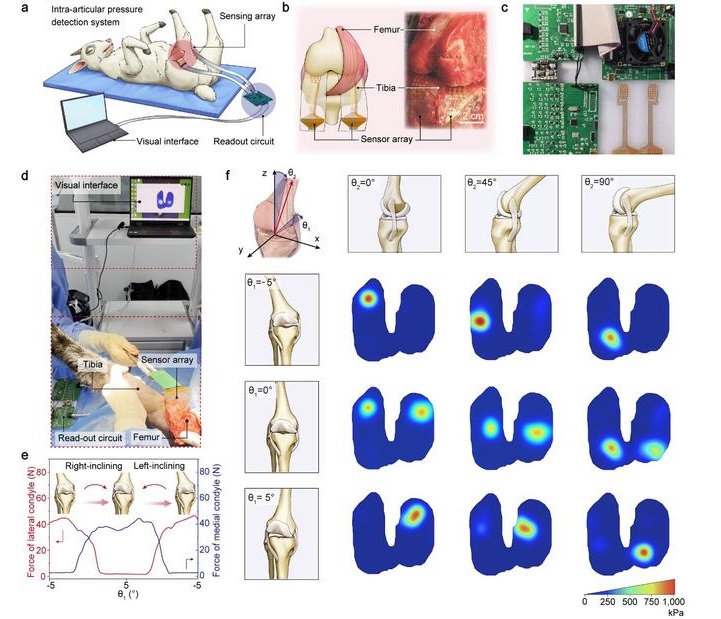Novel Sensory System Enables Real-Time Intra-Articular Pressure Monitoring
|
By HospiMedica International staff writers Posted on 25 Nov 2024 |

Knee replacement surgery is a widely performed procedure to relieve knee pain and restore joint function, with over one million surgeries conducted annually. However, 10%-20% of patients remain dissatisfied with the results, and this rate continues to rise. Postoperative complications often stem from slight interosseous angle deviations (<1°) and large joint gaps, which occur due to pressure imbalances on the tibial plateau. To address this, real-time intra-articular pressure monitoring can help correct pressure imbalances during surgery, ensuring precise joint alignment. However, intra-articular pressure monitoring presents challenges due to the highly humid joint cavity filled with synovial fluid and the narrow, curved space of the joint.
Flexible iontronic pressure sensors, which are soft, thin, and highly sensitive, are ideal for intra-articular pressure sensing. These sensors also have a wide working range. However, the mechanical and electrical properties of ionogels, the active materials used in these sensors, are highly sensitive to humidity changes due to their hygroscopic nature. This humidity sensitivity causes signal distortion and drift, making them unsuitable for implantable applications. Furthermore, ionogels are often too weak to withstand the high pressure needed for intra-articular pressure measurement.
Now, a research team from Southern University of Science and Technology (Shenzhen, China) has developed a non-hygroscopic, strong, and durable ionogel. Ionogels are typically hydrophobic because of the high polarity of ions, but this team synthesized the material by inducing a hydrophobicity transition—the reagents are hydrophilic, but the final product is hydrophobic. This new ionogel maintains stable mechanical and electrical properties regardless of ambient humidity. A flexible pressure sensor array made from this ionogel, featuring a stretchable island-bridge structure, demonstrates resistance to both humidity and lateral strain.
The ionogel's high modulus and strength enable it to provide highly sensitive and linear responses across a wide pressure range of 0-2 MPa, offering exceptional pressure and angular resolution. The team further tested the sensor arrays in an in vivo sheep model, successfully monitoring intra-articular pressure in real-time through a data acquisition system. Published in National Science Review, this research suggests that such sensory systems could be valuable for various implantable applications.
Latest Surgical Techniques News
- New Transcatheter Valve Found Safe and Effective for Treating Aortic Regurgitation
- Minimally Invasive Valve Repair Reduces Hospitalizations in Severe Tricuspid Regurgitation Patients
- Tiny Robotic Tools Powered by Magnetic Fields to Enable Minimally Invasive Brain Surgery
- Magnetic Tweezers Make Robotic Surgery Safer and More Precise
- AI-Powered Surgical Planning Tool Improves Pre-Op Planning
- Novel Sensing System Restores Missing Sense of Touch in Minimally Invasive Surgery
- Headset-Based AR Navigation System Improves EVD Placement
- Higher Electrode Density Improves Epilepsy Surgery by Pinpointing Where Seizures Begin
- Open-Source Tool Optimizes Placement of Visual Brain Implants
- Easy-To-Apply Gel Could Prevent Formation of Post-Surgical Abdominal Adhesions
- Groundbreaking Leadless Pacemaker to Prevent Invasive Surgeries for Children
- Spectroscopy Technique Improves Surgery for Pediatric Epilepsy Patients
- Bioengineered Arteries Show Promise for Cardiovascular Surgery
- Online Tool Guides Surgical Decisions for Gallbladder Cancer
- Innovative Technology Enables Rapid Life-Saving Surgical Leak Detection
- First-Of-Its-Kind Bioresorbable Implant to Help Children with Rare Respiratory Disease
Channels
Critical Care
view channel
Mass Manufactured Nanoparticles to Deliver Cancer Drugs Directly to Tumors
Polymer-coated nanoparticles loaded with therapeutic drugs hold significant potential for treating cancers, including ovarian cancer. These particles can be precisely directed to tumors, delivering their... Read more
World’s Smallest Pacemaker Fits Inside Syringe Tip
After heart surgery, many patients require temporary pacemakers either to regulate the heart rate while waiting for a permanent pacemaker or to support normal heart rhythm during recovery.... Read more
AI-Powered, Internet-Connected Medical Devices to Revolutionize Healthcare, Finds Study
A new study suggests that artificial intelligence (AI)-powered, internet-connected medical devices have the potential to transform healthcare by enabling earlier detection of diseases, real-time patient... Read morePatient Care
view channel
Portable Biosensor Platform to Reduce Hospital-Acquired Infections
Approximately 4 million patients in the European Union acquire healthcare-associated infections (HAIs) or nosocomial infections each year, with around 37,000 deaths directly resulting from these infections,... Read moreFirst-Of-Its-Kind Portable Germicidal Light Technology Disinfects High-Touch Clinical Surfaces in Seconds
Reducing healthcare-acquired infections (HAIs) remains a pressing issue within global healthcare systems. In the United States alone, 1.7 million patients contract HAIs annually, leading to approximately... Read more
Surgical Capacity Optimization Solution Helps Hospitals Boost OR Utilization
An innovative solution has the capability to transform surgical capacity utilization by targeting the root cause of surgical block time inefficiencies. Fujitsu Limited’s (Tokyo, Japan) Surgical Capacity... Read more
Game-Changing Innovation in Surgical Instrument Sterilization Significantly Improves OR Throughput
A groundbreaking innovation enables hospitals to significantly improve instrument processing time and throughput in operating rooms (ORs) and sterile processing departments. Turbett Surgical, Inc.... Read moreHealth IT
view channel
Printable Molecule-Selective Nanoparticles Enable Mass Production of Wearable Biosensors
The future of medicine is likely to focus on the personalization of healthcare—understanding exactly what an individual requires and delivering the appropriate combination of nutrients, metabolites, and... Read more
Smartwatches Could Detect Congestive Heart Failure
Diagnosing congestive heart failure (CHF) typically requires expensive and time-consuming imaging techniques like echocardiography, also known as cardiac ultrasound. Previously, detecting CHF by analyzing... Read morePoint of Care
view channel
Handheld, Sound-Based Diagnostic System Delivers Bedside Blood Test Results in An Hour
Patients who go to a doctor for a blood test often have to contend with a needle and syringe, followed by a long wait—sometimes hours or even days—for lab results. Scientists have been working hard to... Read moreBusiness
view channel
Expanded Collaboration to Transform OR Technology Through AI and Automation
The expansion of an existing collaboration between three leading companies aims to develop artificial intelligence (AI)-driven solutions for smart operating rooms with sophisticated monitoring and automation.... Read more

















